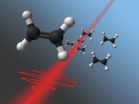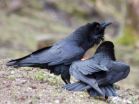(Press-News.org) Some manufacturers are turning away from using triclosan as an antimicrobial ingredient in soaps, toothpastes and other products over health concerns. And now scientists are reporting new evidence that appears to support these worries. Their study, published in the ACS journal Chemical Research in Toxicology, found that triclosan, as well as another commercial substance called octylphenol, promoted the growth of human breast cancer cells in lab dishes and breast cancer tumors in mice.
Kyung-Chul Choi and colleagues note that hormonal imbalances seem to play a role in the development of breast cancer. Given that link, researchers are investigating whether endocrine-disrupting chemicals (EDCs), which are compounds that act like hormones, might spur cancer cell growth. EDCs have become ubiquitous in products, in the environment and even in our bodies. Research has found that two EDCs — triclosan, an antimicrobial ingredient in many products, including soaps, cosmetics and cutting boards; and octylphenol, which is in some paints, pesticides and plastics — have accumulated in the environment. Additionally, triclosan is reportedly in the urine of an estimated 75 percent of Americans. Choi's team wanted to see what effect the two compounds have on breast cancer cells.
In tests on human breast cancer cells and in special immunodeficient mice with tissue grafts, the scientists found that both agents interfered with genes involved with breast cancer cell growth, resulting in more cancer cells. Mice that were exposed to the two compounds had larger and denser breast cancer tumors than the control group. "Although the doses of EDCs were somewhat high, we did this to simulate their effects of daily exposure, as well as body accumulation due to long-term exposure, simultaneously in animal experiments," said Choi. "Thus, exposure to EDCs may significantly increase the risk of breast cancer development and adversely affect human health," the researchers state in the paper.
INFORMATION:The authors cite funding from the National Research Foundation of Korea and the Rural Development Administration of Korea.
The American Chemical Society is a nonprofit organization chartered by the U.S. Congress. With more than 161,000 members, ACS is the world's largest scientific society and a global leader in providing access to chemistry-related research through its multiple databases, peer-reviewed journals and scientific conferences. Its main offices are in Washington, D.C., and Columbus, Ohio.
To automatically receive news releases from the American Chemical Society, contact newsroom@acs.org.
Follow us: Twitter | Facebook
In lab tests, the antimicrobial ingredient triclosan spurs growth of breast cancer cells
2014-04-23
ELSE PRESS RELEASES FROM THIS DATE:
Male-biased tweeting
2014-04-23
This news release is available in German. It all started out with a comic strip in 1985. A cartoon character explained to her female companion which three requirements a movie had to fulfil for her to want to watch it: (one) it has to have at least two women in it (two) who talk to each other about (three) something besides a man. Born was the Bechdel test, named after American cartoonist Alison Bechdel. The test reveals whether a movie features a minimum of female independence.
A lot of Hollywood movies fail the Bechdel test miserably. That movies like "Star Wars" ...
Female intuition could be linked to lower exposure to testosterone in women while in womb
2014-04-23
This news release is available in Spanish.
So-called "female intuition" could actually have a biological component, related to the lower prenatal exposure to testosterone women receive in the womb. This would lead them to have a "more intuitive and less reflective" attitude to life than men. These are the results of a study carried out by Spanish researchers from the University of Granada, the Barcelona Pompeu Fabra University and the Middlesex University of London, in an article recently published in the journal Psychoneuroendocrinology.
According to previous ...
Steering chemical reactions with laser pulses
2014-04-23
Usually, chemical reactions just take their course, much like a ball rolling downhill. However, it is also possible to deliberately control chemical reactions: at the Vienna University of Technology, molecules are hit with femtosecond laser pulses, changing the distribution of electrons in the molecule. This interaction is so short that at first it does not have any discernable influence on the atomic nuclei, which have much more mass than the electrons. However, the disturbance of the electron distribution can still initiate chemical processes and eventually separate ...
Uniting community development efforts could benefit members of underserved communities
2014-04-23
COLUMBIA, Mo. –Research shows that wealth inequality creates barriers to community development, due to the widespread effects of poverty. A report by the United Nations Children's Fund shows that more than one in five children in the United States falls below the poverty line. Although many organizations address poverty, they often serve similar demographics and may compete for clients and resources. Recently, University of Missouri researchers studied Cooperative Extension's efforts to link community development organizations and concluded Extension is the hub that can ...
Remote surveillance may increase chance of survival for 'uncontacted' Brazilian tribes
2014-04-23
COLUMBIA, Mo. – Lowland South America, including the Amazon Basin, harbors most of the last indigenous societies that have limited contact with the outside world. Studying these tribes, located deep within Amazonian rainforests, gives scientists a glimpse at what tribal cultures may have been like before the arrival of Europeans. Now, researchers at the University of Missouri have used satellite images to assess the demographic health of one particular village of isolated people on the border between Brazil and Peru. Remote surveillance is the only method to safely track ...
Impact of whooping cough vaccination revealed
2014-04-23
The most comprehensive study to date of the family of bacteria that causes whooping cough points to more effective vaccine strategies and reveals surprising findings about the bacteria's origin and evolution. The new results could alter public health strategies to control this respiratory disease, which kills 195,000 children worldwide each year.
Genomic analysis of 343 strains of the Bordetella pertussis bacteria from around the world collected over the last 100 years illustrates how vaccination has shaped its evolution. Since its introduction across the globe between ...
Loss of memory in Alzheimer's mice models reversed through gene therapy
2014-04-23
Alzheimer's disease is the first cause of dementia and affects some 400,000 people in Spain alone. However, no effective cure has yet been found. One of the reasons for this is the lack of knowledge on the cellular mechanisms which cause alterations in nerve transmissions and the loss of memory in the initial stages of the disease.
Researchers from the Institute of Neuroscience at the Universitat Autònoma de Barcelona have discovered the cellular mechanism involved in memory consolidation and were able to develop a gene therapy which reverses the loss of memory in mice ...
Liquid spacetime
2014-04-23
What if spacetime were a kind of fluid? This is the question tackled by theoretical physicists working on quantum gravity by creating models attempting to reconcile gravity and quantum mechanics. Some of these models predict that spacetime at the Planck scale (10-33cm) is no longer continuous – as held by classical physics – but discrete in nature. Just like the solids or fluids we come into contact with every day, which can be seen as made up of atoms and molecules when observed at sufficient resolution. A structure of this kind generally implies, at very high energies, ...
How Australia got the hump with 1 million feral camels
2014-04-23
A new study by a University of Exeter researcher has shed light on how an estimated one million-strong population of wild camels thriving in Australia's remote outback have become reviled as pests and culled on a large scale.
Sarah Crowley, of the Environment and Sustainability Institute at the University of Exeter's Penryn Campus, explored the history of the camel in Australia, from their historic role helping to create the country's infrastructure through to their current status as unwelcome "invader."
The deserts of the Australian outback are a notoriously inhospitable ...
Ravens understand the relations among others
2014-04-23
Like many social mammals, ravens form different types of social relationships – they may be friends, kin, or partners and they also form strict dominance relations. From a cognitive perspective, understanding one's own relationships to others is a key ability in daily social life ("knowing who is nice or not"). Yet, understanding also the relationships group members have with each other sets the stage for "political" maneuvers ("knowing who might support whom"). The results of this study have been published in the scientific journal Nature Communications.
A team of researchers ...





